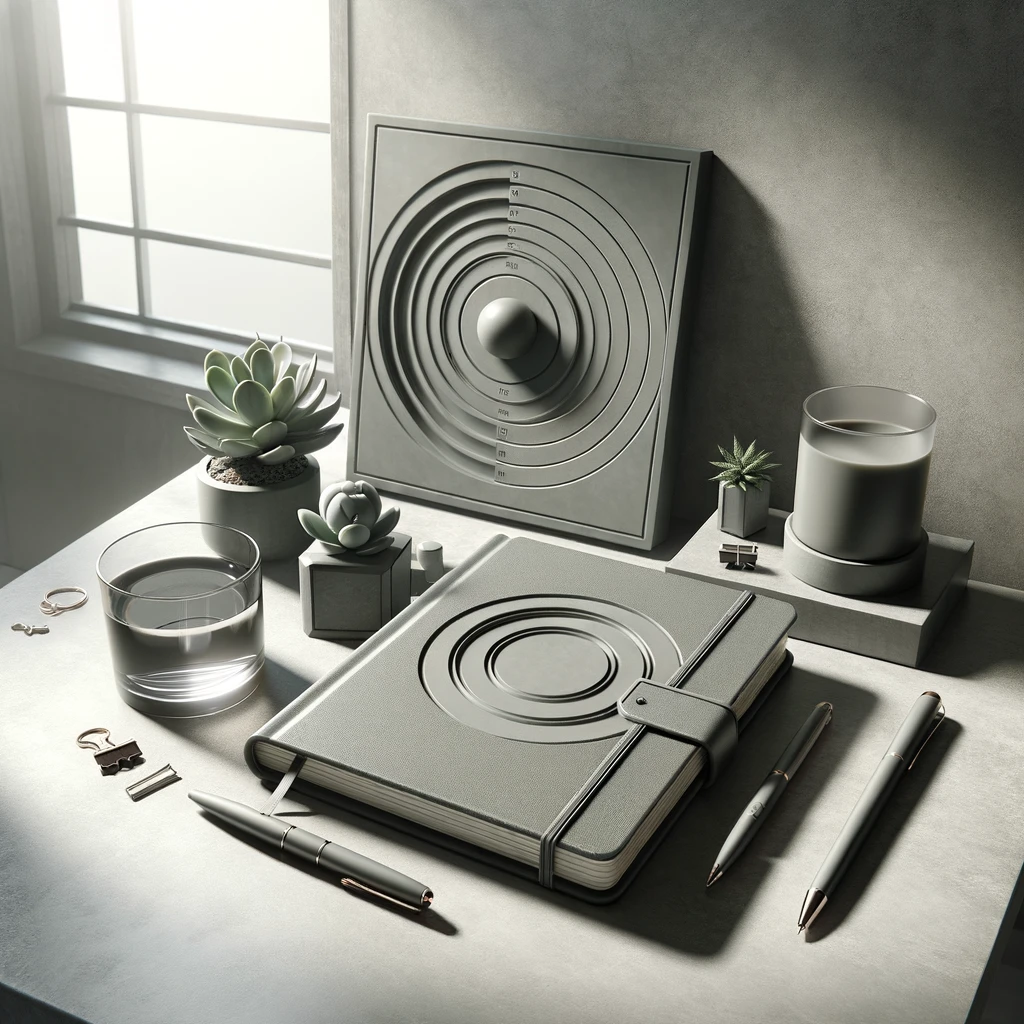This article contains affiliate links. If you click through and make a purchase, I’ll earn a commission, at no additional cost to you. Read my full disclosure here.
Keeping a self-love journal can be a transformative practice for improving your mental health and overall wellbeing. It’s a way to connect with your inner self, understand your emotions, and cultivate self-love and self-compassion. In this article, we’ll explore the benefits of keeping a self-love journal, how to choose the right journal for you, and how to set up a journaling space that inspires you to write.
Journaling can be a powerful tool for self-reflection and personal growth. It allows you to explore your thoughts and feelings, gain clarity on your goals and values, and identify patterns and behaviors that may be holding you back. By keeping a self-love journal, you can focus on cultivating a positive relationship with yourself, which can improve your self-esteem, reduce stress and anxiety, and enhance your overall quality of life.
Key Takeaways
- Keeping a self-love journal can help you cultivate self-love and self-compassion, improve your mental health, and enhance your overall quality of life.
- Choosing the right journal and setting up a journaling space that inspires you to write can help you establish a consistent journaling routine.
- Experimenting with different journaling techniques, incorporating creative elements into your journal, and reviewing and reflecting on your entries can help you overcome journaling challenges and evolve your journaling practice over time.
Benefits of Keeping a Self Love Journal

Keeping a self love journal can have many benefits for your mental and emotional well-being. Here are some of the benefits you can experience by keeping a self love journal:
1. Increased self-awareness
Writing in a self love journal can help you become more aware of your thoughts, feelings, and behaviors. By reflecting on your experiences and emotions, you can gain a deeper understanding of yourself and your needs. This increased self-awareness can help you make more informed decisions and improve your relationships with others.
2. Improved self-esteem
Keeping a self love journal can also help improve your self-esteem. By focusing on your positive qualities and accomplishments, you can develop a more positive and empowering self-image. Additionally, writing down your goals and aspirations can help you stay motivated and focused on achieving your dreams.
3. Reduced stress and anxiety
Writing in a self love journal can be a therapeutic way to reduce stress and anxiety. By expressing your emotions and thoughts on paper, you can release pent-up feelings and gain a sense of clarity and perspective. This can help you feel more relaxed and calm, and better equipped to handle life’s challenges.
4. Increased creativity
Keeping a self love journal can also help boost your creativity. By regularly engaging in the practice of writing, you can develop your writing skills and explore new ideas and perspectives. This can help you become more creative in other areas of your life, such as problem-solving, art, and music.
5. Improved overall well-being
Finally, keeping a self love journal can contribute to your overall well-being. By taking time to reflect on your experiences and emotions, you can develop a greater sense of self-awareness, self-acceptance, and self-love. This can help you feel more fulfilled, content, and happy in your life.
Choosing Your Journal

When it comes to keeping a self-love journal, choosing the right journal is important. You want to find a journal that you enjoy writing in and that reflects your personality. Here are some tips to help you choose the perfect journal for your self-love journey:
- Size: Consider the size of the journal you want to use. Do you want something small and portable that you can take with you wherever you go? Or do you prefer something larger with more space to write?
- Paper Quality: Pay attention to the paper quality of the journal. You want to make sure that the paper is thick enough so that ink won’t bleed through to the other side. If you prefer to use markers or other types of pens, you may want to consider a journal with thicker paper.
- Design: Choose a journal with a design that speaks to you. Whether you prefer a minimalist look or something with colorful designs, there are plenty of options available. You can even find journals with inspirational quotes or prompts to help guide your writing.
- Binding: Consider the binding of the journal. Do you prefer a spiral-bound journal that lays flat when opened? Or do you prefer a journal with a traditional binding that you can keep on a bookshelf?
Remember, the most important thing is to choose a journal that you enjoy writing in. Don’t be afraid to shop around and try out different types of journals until you find the perfect one for you.
Setting Up Your Journaling Space
Before you start journaling for self-love, it’s essential to create a comfortable and inspiring space to write. This space should be free from distractions and provide a relaxing environment that encourages self-reflection. Here are some tips for setting up your journaling space:
Find a Quiet Place
Find a quiet place where you can be alone with your thoughts. This could be a cozy corner of your room, a peaceful spot in your garden, or a quiet park bench. Make sure the space is free from noise and distractions, so you can focus on your writing.
Gather Your Supplies
Gather all the supplies you need for your journaling practice. This might include a notebook, a pen, stickers, colored pencils, or any other materials that inspire you. Having everything you need in one place will make it easier to get started and keep you motivated.
Create a Comfortable Atmosphere
Create a comfortable atmosphere that helps you relax and feel at ease. You might want to light some candles, play soft music, or diffuse some essential oils. Whatever helps you feel calm and centered, make sure to incorporate it into your journaling space.
Set a Regular Time
Set aside a regular time each day to journal. This could be first thing in the morning, during your lunch break, or before bed. By establishing a regular routine, you’ll be more likely to stick with your practice and make it a habit.
Make it Your Own
Finally, make your journaling space your own. Decorate it with things that inspire you, such as photos, quotes, or artwork. Personalize your journaling practice to reflect your unique style and personality. Remember, this is your space to explore your thoughts and feelings, so make it as comfortable and inviting as possible.
Establishing a Journaling Routine
When it comes to keeping a self-love journal, establishing a routine is essential. Setting aside time each day or week to reflect on your thoughts and emotions can help you develop a deeper understanding of yourself and promote self-awareness. Here are some tips to help you establish a journaling routine that works for you.
Determining Frequency
The first step in establishing a journaling routine is to determine how often you want to journal. Some people prefer to journal every day, while others choose to do it once a week. There is no right or wrong answer when it comes to frequency, as long as you are consistent.
Consider your schedule and how much time you can realistically dedicate to journaling. If you are short on time, try journaling for just a few minutes each day. If you have more time, you may want to set aside an hour or more each week to reflect on your thoughts and emotions.
Best Times to Journal
The next step is to determine the best time to journal. Some people prefer to journal in the morning, as it can help set a positive tone for the day ahead. Others prefer to journal in the evening, as it can help them unwind and reflect on the day.
Consider your own energy levels and when you feel most creative and introspective. If you are a morning person, try journaling first thing in the morning. If you are a night owl, consider journaling before bed.
Ultimately, the best time to journal is whenever you can make it a consistent part of your routine. Whether you choose to journal in the morning, evening, or any time in between, the most important thing is to make it a habit. By committing to a regular journaling practice, you can promote self-awareness, develop a deeper understanding of yourself, and cultivate a greater sense of self-love.
Journaling Techniques

When it comes to keeping a self-love journal, there are various techniques you can use to make the most out of your journaling practice. Here are some techniques to consider:
Gratitude Entries
One technique to try is to incorporate gratitude entries into your journaling practice. This involves taking time to reflect on the things in your life that you are grateful for. You can create a list of things you are grateful for each day or write a paragraph about one thing you are particularly grateful for. This technique can help shift your focus away from negative thoughts and towards the positive aspects of your life.
Affirmation Practice
Another technique to consider is an affirmation practice. This involves writing down positive affirmations about yourself and your life. These affirmations can help you build self-confidence and self-esteem. You can create a list of affirmations to read each day or write a new affirmation each day. Make sure your affirmations are specific and meaningful to you.
Reflective Prompts
Reflective prompts are another technique you can use to keep a self-love journal. Reflective prompts are questions or statements that encourage you to reflect on your thoughts, feelings, and experiences. You can use these prompts to gain insight into yourself and your life. Some examples of reflective prompts include “What am I feeling right now?”, “What can I do to take care of myself today?”, and “What is one thing I can do to show myself love today?”.
Free Writing
Free writing is a technique where you write down whatever comes to mind without worrying about grammar, spelling, or punctuation. This technique can help you access your subconscious mind and tap into your creativity. You can use free writing to explore your thoughts and feelings or to brainstorm ideas for personal growth. Set a timer for 10-15 minutes and write down whatever comes to mind. Don’t worry about making sense or being perfect. Just let your thoughts flow onto the page.
These are just a few techniques you can use to keep a self-love journal. Try out different techniques and see what works best for you. Remember, the most important thing is to be consistent with your journaling practice and to make it a priority in your life.
Creative Aspects of Journaling
Journaling is not just about writing down your thoughts and feelings. It can also be a creative outlet that allows you to express yourself in different ways. Incorporating art and color into your journal can make it more visually appealing and fun to look at. Here are some ways you can get creative with your self-love journal:
Incorporating Art and Color
One way to add some creativity to your journal is by incorporating art and color. You don’t have to be an artist to do this. You can simply add some color to your pages with markers, colored pencils, or highlighters. You can also add some doodles or drawings to your pages to make them more interesting. This can help you express yourself in a more visual way and make your journal more enjoyable to look at.
Using Stickers and Washi Tape
Another way to add some creativity to your journal is by using stickers and washi tape. You can use stickers to add some personality to your pages. You can use them to highlight important thoughts or feelings, or to add some fun to your pages. Washi tape is also a great way to add some color and interest to your pages. You can use it to create borders, to highlight important thoughts, or to just add some fun to your pages. Using stickers and washi tape can make your journal more visually appealing and fun to look at.
Overall, incorporating art and color into your self-love journal can make it more enjoyable to write in and more fun to look at. It can also help you express yourself in different ways and add some personality to your journal. So, don’t be afraid to get creative and have fun with your journal!
Overcoming Journaling Challenges

Journaling can be a powerful tool for self-love and self-discovery, but it’s not always easy to get started or stay consistent. Here are some common challenges you may face when trying to keep a self-love journal, and some tips for overcoming them.
Dealing with Writer’s Block
One of the most common challenges when it comes to journaling is writer’s block. You may sit down to write and find that you don’t know what to say or where to start. Here are some tips to help you overcome writer’s block:
- Set a timer: Sometimes all you need is a little structure to get started. Set a timer for 10-15 minutes and write whatever comes to mind. Don’t worry about spelling, grammar, or even making sense. Just write.
- Use prompts: Prompts can be a great way to get your creative juices flowing. Look for prompts online or in books, or come up with your own. Some prompts to get you started include: “What are three things you’re grateful for today?”, “What’s something you’re proud of yourself for?”, or “What’s something you’re looking forward to?”
- Change your environment: Sometimes a change of scenery can help you break through writer’s block. Try writing outside, in a coffee shop, or in a different room in your home.
Maintaining Privacy
Another challenge when it comes to journaling is maintaining privacy. You may worry about someone else reading your journal, or feel self-conscious about what you’re writing. Here are some tips to help you maintain your privacy:
- Lock it up: If you’re worried about someone else reading your journal, consider keeping it in a locked drawer or box. You could also use a journal with a lock or password-protected journaling app.
- Write for yourself: Remember that your journal is for you, and you alone. You don’t have to worry about what anyone else thinks or feels about what you’re writing. Write whatever you need to in order to process your thoughts and emotions.
- Be honest with yourself: It can be tempting to censor yourself or sugarcoat your feelings in your journal, but that defeats the purpose of journaling. Be honest with yourself, even if it’s uncomfortable or painful. Remember that your journal is a safe space for you to express yourself without judgment.
By overcoming these challenges, you can create a consistent journaling practice that will help you cultivate self-love and self-awareness.
Reviewing and Reflecting on Your Entries

Once you’ve started your self-love journal, it’s important to take the time to review and reflect on your entries. This allows you to gain a deeper understanding of yourself and your thought patterns.
One way to review your entries is to look for patterns. Are there certain themes or topics that come up repeatedly? This can help you identify areas of your life that may need more attention or work.
Another helpful technique is to use a highlighter or different colored pen to mark entries that are particularly meaningful or insightful. This makes it easy to go back and find those entries later on when you need a reminder or inspiration.
It’s also important to reflect on your entries. Take some time to think about what you’ve written and how it makes you feel. Are there any new insights or realizations that you’ve gained? What actions can you take to address any challenges or issues that you’ve identified?
Reflecting on your entries can also help you track your progress over time. You may notice that your entries become more positive or that you’re able to handle difficult situations in a more constructive way.
In summary, reviewing and reflecting on your self-love journal entries is a crucial part of the process. It helps you gain insight into yourself and your thought patterns, identify areas that need attention, and track your progress over time.
Evolving Your Journaling Practice

Now that you’ve started your self-love journal, it’s important to keep in mind that your journaling practice can evolve over time. As you grow and change, your journaling needs may change as well. Here are some tips to help you keep your journaling practice fresh and effective:
Try Different Prompts
While it’s important to have a consistent routine when it comes to journaling, it can also be helpful to switch up your prompts every once in a while. This can help you tap into different aspects of your self-love journey and keep your writing practice interesting. You can find a variety of self-love journal prompts online, or you can come up with your own.
Incorporate Other Forms of Self-Care
Journaling is just one form of self-care, and it can be helpful to incorporate other practices into your routine as well. This can include things like meditation, yoga, or spending time in nature. By taking care of your mind and body in different ways, you can deepen your self-love practice and improve your overall well-being.
Reflect on Your Progress
As you continue to journal, it can be helpful to look back on your entries and reflect on your progress. This can help you see how far you’ve come and identify areas where you still need to focus your attention. You can also use this reflection time to set new goals for yourself and come up with new strategies for practicing self-love.
Remember, your self-love journey is unique to you, and your journaling practice should reflect that. By staying open to new ideas and approaches, you can continue to grow and evolve your practice over time.
Frequently Asked Questions
What are some creative prompts for starting a self-love journal?
If you’re new to journaling, it can be difficult to know where to start. Here are some prompts to help you get started with your self-love journal:
- Write a letter to your younger self
- List your favorite qualities about yourself
- Describe a moment when you felt proud of yourself
- Write down a compliment someone gave you and how it made you feel
- Reflect on a time when you overcame a challenge
- Write down positive affirmations to repeat to yourself daily
Can journaling improve my self-esteem and confidence?
Yes, journaling can be a powerful tool for improving self-esteem and confidence. By reflecting on your thoughts and feelings, you can gain a better understanding of yourself and your strengths. Writing down positive affirmations and accomplishments can also help boost your self-esteem.
What’s a good structure to follow when writing in a self-love journal?
There’s no right or wrong way to structure your self-love journal, but some people find it helpful to follow a consistent format. Here’s an example of a structure you could follow:
- Start with a positive affirmation or quote to set the tone for your journal entry
- Reflect on your day or week and write down any thoughts or feelings that come to mind
- Write down something you’re proud of or grateful for
- Set an intention for the next day or week
Where can I find free resources or worksheets for self-esteem journaling?
There are many free resources available online for self-esteem journaling. Here are a few websites to check out:
What kind of entries should I include in my self-love journal?
Your self-love journal should include anything that helps you reflect on and appreciate yourself. Here are some ideas for journal entries:
- Gratitude lists
- Positive affirmations
- Reflections on accomplishments or challenges overcome
- Letters to yourself
- Self-care ideas and plans
How often should I write in my self-love journal to see benefits?
You can write in your self-love journal as often as you like, but many people find that writing daily or a few times a week is beneficial. The key is to make it a consistent habit and take the time to reflect on your thoughts and feelings.

